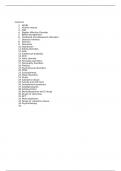Summary
Summary of psychiatric conditions
- Course
- Institution
Lecture notes and summary of psychiatric conditions. Contains information about clinical features of each condition, as well as relevant diagnostic tests and investigations, risk factors, causes and management guidelines. Everything has been cross referenced with passmedicine or Zero to finals an...
[Show more]



